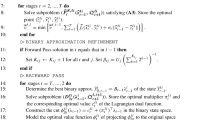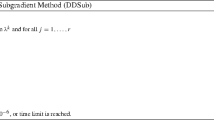Abstract
The creation and ongoing management of a large economic model can be greatly simplified if the model is managed in separate smaller pieces defined, e.g. by region or commodity. For this purpose, we define an extension of Dantzig–Wolfe decomposition for the variational inequality (VI) problem, a modeling framework that is widely used for models of competitive or oligopolistic markets. The subproblem, a collection of independent smaller models, is a relaxed VI missing some “difficult” constraints. The subproblem is modified at each iteration by information passed from the last solution of the master problem in a manner analogous to Dantzig–Wolfe decomposition for optimization models. The master problem is a VI which forms convex combinations of proposals from the subproblem, and enforces the difficult constraints. A valid stopping condition is derived in which a scalar quantity, called the “convergence gap,” is monitored. The convergence gap is a generalization of the primal-dual gap that is commonly monitored in implementations of Dantzig–Wolfe decomposition for optimization models. Convergence is proved under conditions general enough to be applicable to many models. An illustration is provided for a two-region competitive model of Canadian energy markets.
Similar content being viewed by others
References
Ahn, B.H. (1979). Computation of Market Equilibrium for Policy Analysis: the Project Independence Evaluation System Approach. Ph.D. Dissertation, Department of Engineering-Economic System, Stanford University; also a book, Garland Publishing Inc.
Ahn, B.H. and Hogan, W.W. (1982). On convergence of the PIES algorithm for computing equilibria. Operations Research, 30, 281–300.
Auslender, A. and Teboulle, M. (2001). Entropic proximal decomposition methods for convex programs and variational inequalities. Mathematical Programming, Series A, 91, 33–47.
Bahn, O., Haurie, A., Kypreos, S. and Vial, J.-P. (1996). A decomposition approach to multiregional environmental planning: A numerical study. In C. Carraro, A. Haurie (eds.), Operations Research and Environmental Management, 119–132. Kluwer Academic Publishers, Drodrecht.
Barton, R.R., Hearn, D.W. and Lawphongpanich, S. (1989). The equivalence of transfer and generalized benders decomposition methods for traffic assignment. Transportation Research, 23B, 61–73.
Brooke, A., Kendrick, D. and Meeraus, A. (1992). GAMS: A User’s Guide. Release 2.25. The Scientific Press.
Büeler, B. (1997). Solving an equilibrium model for trade of CO2 emission permits. European Journal of Operational Research, 102, 393–403.
Chung, W. (1999). New Decomposition Methods for Economic Equilibrium Models with Applications to Decomposition by Region. Ph.D. Thesis, Department of Management Sciences, University of Waterloo, Waterloo, Ontario, Canada.
Chung, W., Wu, Y.J. and Fuller, J.D. (1997). Dynamic energy and environment equilibrium model for the assessment of CO2 emission control in Canada and the USA. Energy Economics, 19, 103–124.
Chung, W., Fuller, J.D. and Wu, Y.J. (2001). A new demand–supply decomposition method for a class of economic equilibrium models. Computational Economics, 21, 231–243.
Chung, W., Fuller, J.D. and Wu, Y.J. (2003). A new decomposition method for multi-regional economic equilibrium models. Operations Research, in press.
Dantzig, G.B. and Wolfe, P. (1961). The decomposition algorithm for linear programs. Econometric, 29(4), 767–778.
Dirickx, Y.M.I. and Jennergren, L.P. (1979). Systems Analysis by Multilevel Methods. Wiley IIASA International Series on Applied Systems Analysis. Pitman Press.
Dirkse, S.P. and Ferris, M.C. (1995). The PATH solver: A non-monotone stabilization scheme for mixed complementarity problems. Optimization Methods and Software, 5, 123–156.
Fuller, J.D. (1992). A model for the assessment of the impacts of energy free trade on Canada. INFOR, 30, 207–221.
Gabriel, S.A., Kydes, A.S. and Whitman, P. (2001). The national energy modeling system: A large-scale energy-economic equilibrium model. Operations Research, 49(1), 14–25.
Geoffrion, A.M. (1972). Generalized benders decomposition. Journal of Optimization Theory and Applications, 10, 237–260.
Marker, P.T. and Pang, J.S. (1990). Finite-dimensional variational inequality and nonlinear complementarity problems: A survey of theory, algorithms and applications. Mathematical Programming, 48, 161–220.
Han, D. and Sun, W. (2003). New decomposition methods for solving variational inequality problems. Mathematical and Computer Modelling, 37, 405–418.
He, B.S., Liao, L.Z., Han, D. and Yang, H. (2002). A new inexact alternating directions method for monotone variational inequalities. Mathematical Programming, 92, 103–118.
He, B.S., Liao, L.Z. and Yang, H. (1999). Decomposition method for a class of monotone variational inequality problems. Journal of Optimization Theory and Applications, 103, 603–622.
He, B.S. and Yang, H. (1998). Some convergence properties of a method of multipliers for linearly constrained monotone variational inequalities. Operations Research Letters, 23, 151–161.
Hearn, D.W. (1984). Practical and theoretical aspects of aggregation problems in transportation planning models. In Transportation Planning Models. Elsevier Science Publishers.
Hobbs, B.F. (2001). Linear complementarity models of Nash Cournot competition in bilateral and POOLCO power markets. IEEE Transactions on Power Systems, 16, 194–202.
Lawphongpanich, S. and Hearn, D.W. (1984). Simplicial decomposition of the asymmetric traffic assignment problem. Transportation Research, 18B, 123–133.
Lawphongpanich, S. and Hearn, D.W. (1990). Benders decomposition for variational inequalities. Mathematical Programming, 48, 231–247.
Loulou, R. and Kanudia, A. (1999). The Kyoto Protocol, Inter-provincial cooperation, and energy trading: A systems analysis with integrated MARKAL models. Energy Studies Review, 9, 1–23.
Murphy, F.H. (1973). Column dropping procedures for the generalized programming algorithm. Management Science, 19, 1310–1321.
Murphy, F.H. (1993). Making large-scale models manageable: Modeling from an operations management perspective. Operations Research, 41(2), 241–252.
Murphy, F.H., Conti, J.J., Sanders, R. and Shaw, S.H. (1988). Modeling and forecasting energy markets with the intermediate future forecasting system. Operations Research, 36, 406–420.
Murphy, F.H. and Mudrageda, M.V. (1998). A decomposition approach for a class of economic equilibrium models. Operations Research, 46, 368–377.
Nagurney, A. (1999), Network Economics: A Variational Inequality Approach, 2nd and revised edn. Kluwer Academic Publishers, Drodrecht.
Patriksson, M. (1994). The Traffic Assignment Problem: Models and Methods. VSP, The Netherlands.
Patriksson, M. (1999). Nonlinear Programming and Variational Inequality Problems: A Unified Approach. Applied Optimization Series, Vol. 23. Kluwer Academic Publishers, Drodrecht.
Smeers, Y. (2003a). Market incompleteness in regional electricity transmission. Part I: The forward market. Networks and Spatial Economics, 3, 151–174.
Smeers, Y. (2003b). Market incompleteness in regional electricity transmission. Part II: The forward and real time markets. Networks and Spatial Economics, 3, 175–196.
Wei, J.-Y. and Smeers, Y. (1999). Spatial oligopolistic electricity models with Cournot generators and regulated transmission prices. Operations Research, 47, 102–112.
Wu, Y.J. and Chung, W. (1997). Assessing the control of energy-related CO2 emissions with a dynamic energy process model. Energy, The International Journal, 22, 693–704.
Author information
Authors and Affiliations
Rights and permissions
About this article
Cite this article
Fuller, J.D., Chung, W. Dantzig—Wolfe Decomposition of Variational Inequalities. Comput Econ 25, 303–326 (2005). https://doi.org/10.1007/s10614-005-2519-x
Issue Date:
DOI: https://doi.org/10.1007/s10614-005-2519-x




